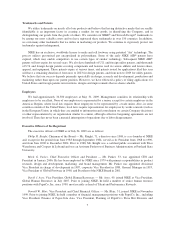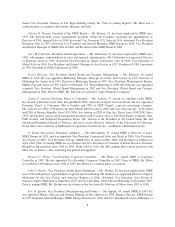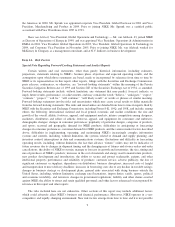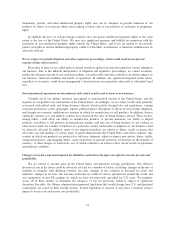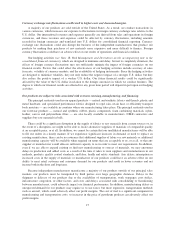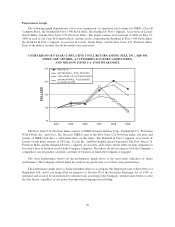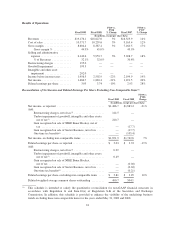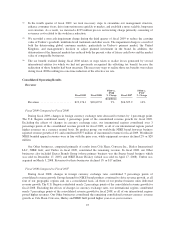Nike 2009 Annual Report Download - page 18
Download and view the complete annual report
Please find page 18 of the 2009 Nike annual report below. You can navigate through the pages in the report by either clicking on the pages listed below, or by using the keyword search tool below to find specific information within the annual report.In addition, Sojitz America performs significant import-export financing services for most of the NIKE
brand products sold outside of the United States, Europe, Middle East, Africa and Japan, excluding products
produced and sold in the same country. Any failure of Sojitz America to provide these services or any failure of
Sojitz America’s banks could disrupt our ability to acquire products from our suppliers and to deliver products to
our customers outside of the United States, Europe, Middle East, Africa, and Japan. Such a disruption could
result in cancelled orders that would adversely affect sales and profitability.
Our success depends on our global distribution facilities.
We distribute our products to customers directly from the factory and through distribution centers located
throughout the world. Our ability to meet customer expectations, manage inventory, complete sales and achieve
objectives for operating efficiencies depends on the proper operation of our distribution facilities, the
development or expansion of additional distribution capabilities, and the timely performance of services by third
parties (including those involved in shipping product to and from our distribution facilities). Our distribution
facilities could be interrupted by information technology problems and disasters such as earthquakes or fires.
Any significant failure in our distribution facilities could result in an adverse affect on our business. We maintain
business interruption insurance, but it may not adequately protect us from adverse effects that could be caused by
significant disruptions in our distribution facilities.
We rely significantly on information technology in our supply chain, and any failure, inadequacy,
interruption or security failure of that technology could harm our ability to effectively operate our business.
We are heavily dependent on information technology systems across our supply chain, including product
design, production, forecasting, ordering, manufacturing, transportation, sales, and distribution. Our ability to
effectively manage and maintain our inventory and to ship products to customers on a timely basis depends
significantly on the reliability of these supply chain systems. Over the last several years, as part of the ongoing
initiative to upgrade our worldwide supply chain, we have implemented new systems in all of our geographical
regions in which we operate. Over the next few years, we will work to continue to enhance the systems and
related processes in our global operations. The failure of these systems to operate effectively, problems with
transitioning to upgraded or replacement systems, or a breach in security of these systems could cause delays in
product fulfillment and reduced efficiency of our operations, and could require significant capital investments to
remediate the problem, and may have an adverse effect on our results of operations and financial condition.
Our financial results may be adversely affected if substantial investments in businesses and operations fail to
produce expected returns.
From time to time, we may invest in business infrastructure, acquisitions of new businesses, and expansion
of existing businesses, such as our retail operations, which require substantial cash investments and management
attention. We believe cost effective investments are essential to business growth and profitability. However,
significant investments are subject to typical risks and uncertainties inherent in acquiring or expanding a
business. The failure of any significant investment to provide the returns or profitability we expect could have a
material adverse effect on our financial results and divert management attention from more profitable business
operations.
We depend on key personnel, the loss of whom would harm our business.
Our future success will depend in part on the continued service of key executive officers and personnel. The
loss of the services of any key individual could harm us. Our future success also depends on our ability to
identify, attract and retain additional qualified personnel. Competition for employees in our industry is intense
and we may not be successful in attracting and retaining such personnel.
16



